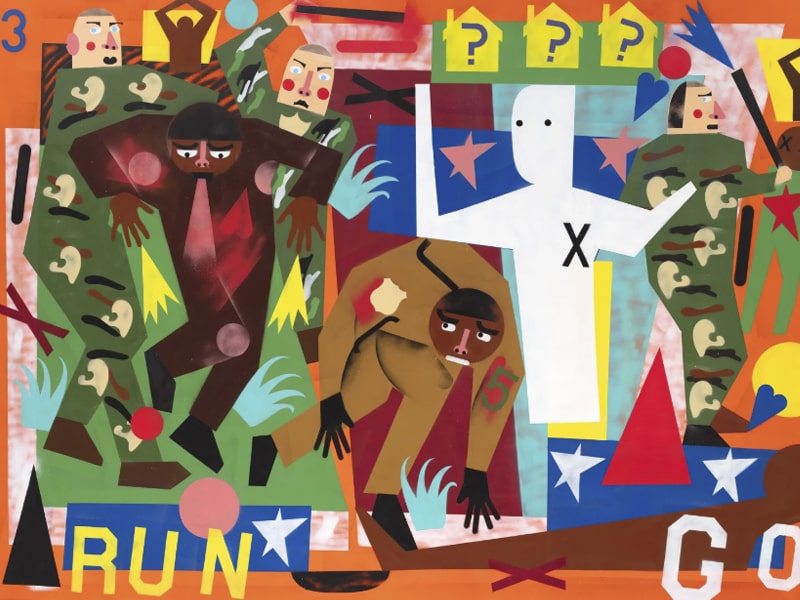The Green Family Art Foundation is pleased to announce its inaugural exhibition Black Bodies, White Spaces: Invisibility & Hypervisibility, an exhibition curated by London-based curator Aindrea Emelife, opening on October 9, 2021 and remaining on view until January 27, 2022.
“Not everything that is faced can be changed. But nothing can be changed until it has been faced. History is not the past. It is the present. We carry our history with us. We are our history.” – James Baldwin
“What we see is political. Taking up space is resistance. Walking through the gallery space hung with pictures, museum-goers act out and internalize a version of history… what happens when this space is infiltrated by those history has sought to exclude? With Black Bodies, White Spaces: Invisibility & Hypervisibilitywe see the coming together of artists exploring the Black body in painting and posit how doing so is a form of resistance.” – Aindrea Emelife, curator
Inspired in part by the pivotal 20th century text “Black Skin, White Masks” by French philosopher Frantz Fanon, this exhibition explores how artists have critiqued, navigated, and engaged with the complexity of constructed and produced Blackness.
Artists include:
| Nina Chanel Abney | Jadé Fadojutimi | Jammie Holmes | Otis Kwame Kye Quaicoe |
| Amoako Boafo | Derek Fordjour | Joy Labinjo | Deborah Roberts |
| Jordan Casteel | Jameson Green | Danielle Mckinney | Amy Sherald |
| Dominic Chambers | David Hammons | Ludovic Nkoth | Henry Taylor |
| Robert Colescott | Barkley L. Hendricks | Toyin Ojih Odutola | Mickalene Thomas |
| Darrel Ellis |
The work in this show depicts a legacy of artists who have expanded the artistic language and public understanding of the role and function of ‘Black art’. From David Hammons’ seminal, politicized printing plate body prints to Henry Taylor’s Guernica-style bandit scene, Mickalene Thomas’ defiant woman to Jadé Fadojutimi’s explorations of the body and gesture through abstraction, this exhibition extols the variability of the body and the modes of representing Blackness through it. Nina Chanel Abney’s Playmobil colored activism coaxes us to question the ethics of authority and sanctioned violence, as does Joy Labinjo’s rendition of a polite, helping British police offer, while Amy Sherald’s cotton candy-colored figures subvert the symbols of oppression in a powerful pastel reclamation of manhood. Barkley L. Hendricks celebrates Black culture and self-determination with his colorful dancing couple who are free to dance as they wish, while Toyin Ojih Odutola’s depiction of imaginary upper class Nigerian families, dressed in chromatic and scintillating silks, upturn western perceptions of the color of royalty.
Furthermore, Danielle Mckinney and Jordan Casteel create introspective depictions of leisure and vulnerability removing the “otherness” taint of the Black body. Blackness is so often aligned with strength and defiance, yet these artists remind us that softness and delicateness touches us all.
Black figuration is not a monolith. The exhibition purposefully incorporates an international perspective, unveiling not only Joy Labinjo’s subtle but powerful commentary about authority, but also Otis Kwame Kye Quaicoe’scolorful beret-wearing youths and Amoako Boafo’s power blue suited gentleman, both of which, along with Amy Sherald’s work, show Blackness that is dressed for success. They achieve this by representing the political use of style, subverting conventional notions of Blackness, maleness and how Black dandyism refutes a single construction of Black masculinity. The artists selected dismantle the function and purpose of art, refashioning it to create dynamic investigations that hold art and its pre-conceptions accountable and demand more from the medium and the viewer.
About the Curator:
Aindrea Emelife is a 27-year-old independent curator from London. Starting at the Courtauld Institute of Art, Emelife fuses art history with contemporary art to explore the realms of representation, identity, social justice and desire in her curatorial and writing practice. In 2021, she was appointed to the Mayor of London’s Commission for Diversity in the Public Realm and listed in Forbes 30 Under 30. Recent exhibitions include Citizens of Memory, The Perimeter London (2021) and her forthcoming books, A Little History of Protest Art (Tate) and Art Can Change The World (Frances Lincoln) debut in 2022.
This article was originally published by the Green Family Art Foundatio

